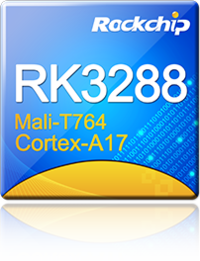Difference between revisions of "RK3288"
| Line 28: | Line 28: | ||
| | ||
| − | + | Integrated with a Quad-Core Cortex-A17 which up to 1.8GHz and ARMMali-T764 which supports openGL ES1.1/2.0/3.0, openVG1.1, OpenCL and DirectX11. Abundant interfaces provide a friendly solution for product development. Futhermore | |
| | ||
| Line 70: | Line 70: | ||
**Support Android 4.2 or up | **Support Android 4.2 or up | ||
| − | = | + | = Devices = |
| − | |||
| − | |||
| − | |||
| − | |||
| − | + | Rockchip: EVB-RK3328 | |
| − | + | Firefly: [[Firefly-RK3288|Firefly-RK3288]]<br/> [[Firefly-RK3288_reload|Firefly-RK3288 reload]]<br/> [[Rock2_Square|Rock2 Square]]<br/> [[Rock2_Full|Rock2 Full]]<br/> [[MiQi|MiQi]]<br/> [[Popmetal|Popmetal]]<br/> [[Fennec|Fennec]]<br/> [[PhyCORE-RK3288|phyCORE-RK3288]] | |
| − | + | ASUS: Tinker board | |
| − | |||
| − | |||
| − | |||
| − | |||
= Documentation = | = Documentation = | ||
| Line 106: | Line 98: | ||
| rk-linux.dts | | rk-linux.dts | ||
|} | |} | ||
| − | |||
| − | |||
| | ||
| Line 129: | Line 119: | ||
| 115200 | | 115200 | ||
|} | |} | ||
| − | |||
| − | |||
| − | |||
| − | |||
| − | |||
| − | |||
| − | |||
| − | |||
| − | |||
| − | |||
| − | |||
| − | |||
| − | |||
| − | |||
| − | |||
| − | |||
| − | |||
| − | |||
| − | |||
| − | |||
| − | |||
| − | |||
| − | |||
| − | |||
| − | |||
| − | |||
| − | |||
| − | |||
| − | |||
| − | |||
| − | |||
| − | |||
| − | |||
| − | |||
| − | |||
| − | |||
| − | |||
| − | |||
| − | |||
| − | |||
| − | |||
| − | |||
| − | |||
| − | |||
| − | |||
| − | |||
| − | |||
| − | |||
| − | |||
| − | |||
| − | |||
| − | |||
| − | |||
| − | |||
| − | |||
| − | |||
| − | |||
| − | |||
| − | |||
| − | |||
| − | |||
| − | |||
| − | |||
| − | |||
| − | |||
| − | |||
| − | |||
| − | |||
| − | |||
| − | |||
| − | |||
= See also = | = See also = | ||
| Line 206: | Line 125: | ||
[[RK3399|RK3399]] | [[RK3399|RK3399]] | ||
| − | |||
| − | |||
| − | |||
| − | |||
| − | |||
| − | |||
= References = | = References = | ||
| − | + | #[https://en.wikipedia.org/wiki/ARM_Cortex-A17 https://en.wikipedia.org/wiki/ARM_Cortex-A17] | |
| − | + | #[http://www.rock-chips.com/a/en/products/RK32_Series/2014/0504/484.html http://www.rock-chips.com/a/en/products/RK32_Series/2014/0504/484.html] | |
| − | |||
| − | |||
| − | |||
| − | |||
| − | [http://www.rock-chips.com/a/en/products/RK32_Series/2014/0504/484.html http://www.rock-chips.com/a/en/products/RK32_Series/2014/0504/484.html] | ||
Revision as of 11:36, 9 March 2017
Integrated with a Quad-Core Cortex-A17 which up to 1.8GHz and ARMMali-T764 which supports openGL ES1.1/2.0/3.0, openVG1.1, OpenCL and DirectX11. Abundant interfaces provide a friendly solution for product development. Futhermore
Contents
Overview
The RK3288 offers an extensible, leading performance,long-standing heritage platform,ideally suited for set-top box solution, tablet and chromebook.The platform is integrated with a Quad-Core Cortex-A17 which up to 1.8GHz and ARM Mali-T764 which supports openGL ES1.1/2.0/3.0, openVG1.1, OpenCL and DirectX11. Abundant interfaces provide a friendly solution for product development. Futhermore, the power consumption is optimal for applications such as imaging/video, communication and broadband infrastructure,and performance audio applications.
RK3288 SoC Features
- CPU:
- Quad Core Cortex-A17 up to 1.8GHz
- 32KB L1-Cache
- 1MB L2-Cache
- GPU:
- ARM Mali-T764 GPU, with TE, ASTC, AFBC technology
- Quad core 3D Graphics engine
- Dual core 2D Graphics engine
- Comply with OpenGL ES1.1/2.0/3.0, OpenVG1.1, OpenCL, DirectX11
- Display:
- 4Kx2K@60fpsHDMI2.0
- Up to 3840X2160 display resolution
- Support dual-channel LVDS/dual-channel MIPI-DSI/eDP1.1
- Camera:
- Support up to 5M pixels
- 8bits/10bits/12bits raw data interface
- Memory:
- Dual channels 64-bit DRAM controller
- Support DDR3/DDR3L, LPDDR2, LPDDR3
- Connectivity:
- Embedded 13M ISP and MIPI-CSI2 interface
- Audio:
- I2S/PCM with 8 channels
- OS:
- Support Android 4.2 or up
Devices
Rockchip: EVB-RK3328
Firefly: Firefly-RK3288
Firefly-RK3288 reload
Rock2 Square
Rock2 Full
MiQi
Popmetal
Fennec
phyCORE-RK3288
ASUS: Tinker board
Documentation
Software
Borad configuration
| board | kernel | uboot | dts |
| RK3288_MAINBOARD_V3.0 | rockchip_linux_defconfig | rk3288_linux_defconfig | rk-linux.dts |
Chip configuration
| chip | Kernel eMMC index | Kernel SD index | Uboot eMMC index | Uboot SD index | Baud speed |
| RK3288 | 1 | 0 | 0 | 1 | 115200 |


